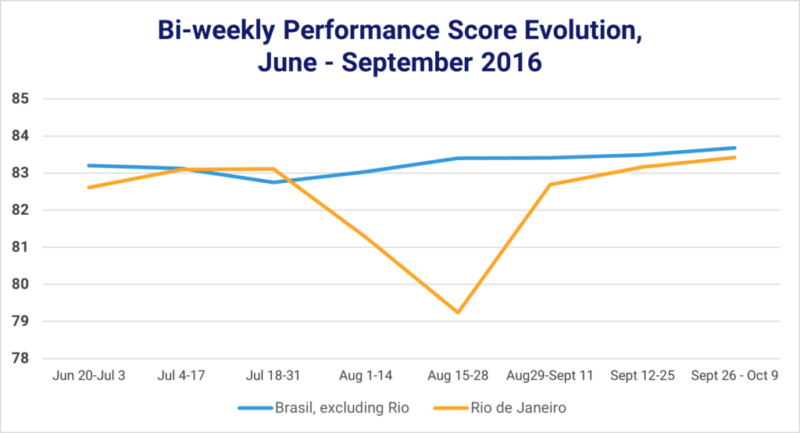Highlights
- U.S. and European results hampered by holiday hangover
- Calendar shifts also played a role in U.S. results
- Limited impact from Los Angeles wildfires
- Japanese hotels still strong
Post-holiday blues
U.S. hotel revenue per available room (RevPAR) hit the skids in the week ending 11 January 2025, falling 13.2% year over year after a 14.9% gain in the week prior. Declines were seen in both occupancy and average daily rate (ADR), which can be attributed to a holiday hangover. Unlike last year, this week was the first full week back to work and school after the holidays and like normal, it was a slow travel week as people got back to their normal routines.
Additionally, the week was also impacted by the shift of the MLK holiday weekend. This slowdown was not unexpected and, in fact, was predicted based on our occupancy-on-the-books data, which showed an 18.1% deficit across top markets in the U.S.
Importantly though, we are not reading too much into the sharp decrease in performance given the factors mentioned above.
The Top 25 Markets fell the most (RevPAR: -16.2%), but the results are somewhat deceiving. San Francisco’s RevPAR was down 78.1%, the most of any market in the U.S. due to a calendar shift with the J.P. Morgan Healthcare Conference, which occurs a week later this year. Excluding San Francisco, RevPAR in the Top 25 Markets was down 9.7% and 9.9% for the total U.S.
Weekends showed the largest RevPAR decline (-15.9%), due more to occupancy (-6.8ppts) than ADR (-4.9%). The change in the MLK holiday was mostly to blame. Weekdays were also soft with RevPAR down 14.1%, but if you exclude San Francisco, the decrease was much less (-8.3%). Shoulder days (Sunday & Thursday) were down the least (-7.7% or -3.9% without San Francisco).
Group demand shifted across the country
San Francisco was not alone in experiencing a conference shift impact. Across Luxury and Upper Upscale hotels, group occupancy was down 4.3% from the same week last year with the Top 25 Markets recording a decrease of 4.7%. Twenty of the Top 25 Markets posted group occupancy declines. Here too we attribute the shift to holidays, and the period being the first full week of the year. However, Atlanta, Philadelphia and Seattle were bright spots, posting double-digit group occupancy gains.
Transient occupancy fell 2.5% nationwide. The measure was down a bit more outside of the Top 25 Markets (-3.4%) and less so in the Top 25 (-1.8%).
Hurricane-affected markets still driving Economy chain scale outperformance
Poor RevPAR performance was seen across all chain scales, except Economy, due primarily to occupancy decreases. The decline narrowed from top to bottom with the top three chain scales down more than 15% and followed by Upper Midscale (-10.6%) and Midscale (-3.3%). Economy posted positive RevPAR comparisons due mainly to markets impacted by Hurricane Helene and Hurricane Milton.
The hurricane markets, which we have now broadened to 13 (Augusta, Charlotte, Columbia, Daytona Beach, Florida Central North, Florida Central South, Georgia South, Greenville/Spartanburg, Macon/Warner Robins, North Carolina West, Sarasota, South Carolina Area, and Tampa) continue to see elevated performance. Occupancy in these markets increased 10 ppts with ADR up 5%, resulting in a RevPAR gain of 22.9%. These markets make up just over 4% of U.S. room demand, and while this is small, the markets are also small, which means the impact on these markets is magnified. Additionally, the supply in many of these markets is in the lower chain scales, and that is where the largest impact has been observed.
Combined Economy and Midscale chains in these markets increased RevPAR 58.8% for the week, followed by Upscale/Upper Midscale chains (RevPAR: +10.2%). The top two chains scales saw RevPAR decline 11.4%. Without the hurricane markets, economy hotels saw a RevPAR decrease of 2.5%.
Los Angeles wildfires affect occupancy
The devastating wildfires in Los Angeles appear to have had a limited impacted on hotel performance thus far. Market demand surged Tuesday through Thursday but then dissipated over the weekend. Occupancy over the three days increased 13.9 ppts year over year with ADR growing 6.4%. It is important to note that the ADR gain was driven by Luxury hotels, which were up 22.7% over those three days. Excluding those hotels, occupancy was still up 14.2ppts, but the accompanying ADR increase was modest (+2.4%) and in line with what is normally seen in displacement situations. We believe the growth in Luxury ADR was due to room mix with higher priced suites being sold in an off week, making for a large percentage gain.
Occupancy declined 5ppts on Friday and Saturday, which was slightly more than what was seen Sunday and Monday (-3.5ppts). Overall, Tuesday through Thursday occupancy averaged 74.9% with the highest level seen in the Pasadena/Glendale/Burbank submarket (83%), an area that contained the Eaton fire. Los Angeles North, an area south of Pasadena and east of the Palisades fire, saw occupancy of 79.2%, which was like the level seen in the Los Angeles Airport submarket. A year ago, these three markets were running average occupancy of 63.7% with Pasadena at 58%.
A full in-depth analysis can be found here.
Global performance mixed
Across the globe, excluding the U.S., RevPAR increased 7.4%. However, this increase was by no means uniform across countries.
- Japan posted the largest RevPAR gain (+24.8%), driven entirely by ADR with Tokyo, Kyoto, Okinawa, Hokkaido and Osaka all seeing double-digit RevPAR gains.
- Mexico continued its strong performance since the U.S. Thanksgiving holiday, and the Mexican Caribbean produced the greatest increase.
- Indonesia’s RevPAR growth (+12.7%) received a boost from its largest market, Bali, which increased RevPAR 25.8%.
- India also saw double-digit RevPAR growth (+11.5%). The eight largest markets in the country (out of 17 total markets) posted positive RevPAR percentage changes with ADR being the primary driver in most markets.
- Like in the U.S. results, several countries across Europe and Canada slowed, which we attribute to the post-holiday lull.
- China’s performance was flat with its top three markets, Shanghai, Beijing and Guangdong recording RevPAR gains.
Final Thoughts
While this week was a bit of a bust in the U.S., the next week of data is expected to be significantly better. Occupancy on the books is up 14.6% in top markets compared with the same week last year. The start of the MLK weekend will provide a weekend boost while causing a slowdown in the following week with the Federal Holiday on Monday, 20 January. Other things we will be watching:
- San Francisco will benefit from the J.P. Morgan Healthcare Conference.
- Washington, D.C. will see a significant boost over the weekend ahead of the U.S. Presidential Inauguration on 20 January. Occupancy on the books in the Washington, D.C. CBD for the Saturday0Monday period was averaging 75% (as of January 13), which is more than double the typical occupancy on the books figure for this weekend.
- Many markets are expected to see convention and conference business pick up along with business travel as we are now well past the holidays.
- The Los Angeles fires will continue to impact the market and surrounding areas. Displaced residents and recovery workers will need a place, which will lift demand, but meeting planners and travelers may avoid the region in the near term, creative a negative impact. We have heard from hoteliers in the market that they are experiencing group and business travel cancellations for this reason.
Globally, hotels in Japan, Mexico, Indonesia and India are expected to remain strong while countries in Europe should see a return to normal business patterns which will produce more stable performance.
*Analysis by Isaac Collazo, Chris Klauda.
*All financial figures in constant USD.
About CoStar Group, Inc.
CoStar Group (NASDAQ: CSGP) is a leading provider of online real estate marketplaces, information, and analytics in the property markets. Founded in 1987, CoStar Group conducts expansive, ongoing research to produce and maintain the largest and most comprehensive database of real estate information. CoStar is the global leader in commercial real estate information, analytics, and news, enabling clients to analyze, interpret and gain unmatched insight on property values, market conditions and availabilities. Apartments.com is the leading online marketplace for renters seeking great apartment homes, providing property managers and owners a proven platform for marketing their properties. LoopNet is the most heavily trafficked online commercial real estate marketplace with thirteen million average monthly global unique visitors. STR provides premium data benchmarking, analytics, and marketplace insights for the global hospitality industry. Ten-X offers a leading platform for conducting commercial real estate online auctions and negotiated bids. Homes.com is the fastest growing online residential marketplace that connects agents, buyers, and sellers. OnTheMarket is a leading residential property portal in the United Kingdom. BureauxLocaux is one of the largest specialized property portals for buying and leasing commercial real estate in France. Business Immo is France’s leading commercial real estate news service. Thomas Daily is Germany’s largest online data pool in the real estate industry. Belbex is the premier source of commercial space available to let and for sale in Spain. CoStar Group’s websites attracted over 163 million average monthly unique visitors in the third quarter of 2024. Headquartered in Washington, DC, CoStar Group maintains offices throughout the U.S., Europe, Canada, and Asia. From time to time, we plan to utilize our corporate website, CoStarGroup.com, as a channel of distribution for material company information. For more information, visit CoStarGroup.com.
This news release includes “forward-looking statements” including, without limitation, statements regarding CoStar’s expectations or beliefs regarding the future. These statements are based upon current beliefs and are subject to many risks and uncertainties that could cause actual results to differ materially from these statements. The following factors, among others, could cause or contribute to such differences: the risk that future media events will not sustain an increase in future occupancy rates. More information about potential factors that could cause results to differ materially from those anticipated in the forward-looking statements include, but are not limited to, those stated in CoStar’s filings from time to time with the Securities and Exchange Commission, including in CoStar’s Annual Report on Form 10-K for the year ended December 31, 2023 and Forms 10-Q for the quarterly periods ended March 31, 2024, June 30, 2024, and September 30, 2023, each of which is filed with the SEC, including in the “Risk Factors” section of those filings, as well as CoStar’s other filings with the SEC available at the SEC’s website (www.sec.gov). All forward-looking statements are based on information available to CoStar on the date hereof, and CoStar assumes no obligation to update or revise any forward-looking statements, whether as a result of new information, future events or otherwise.


















